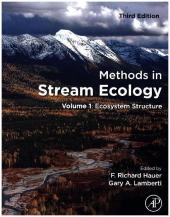 Neuerscheinungen 2017Stand: 2020-02-01 |
Schnellsuche
ISBN/Stichwort/Autor
|
Herderstraße 10
10625 Berlin
Tel.: 030 315 714 16
Fax 030 315 714 14
info@buchspektrum.de |

F. Richard Hauer, Gary A. Lamberti
(Beteiligte)
Methods in Stream Ecology
Ecosystem Structure
Herausgegeben von Hauer, F. Richard; Lamberti, Gary A.
3. Aufl. 2017. 506 S. 276 mm
Verlag/Jahr: ACADEMIC PRESS 2017
ISBN: 0-12-332907-8 (0123329078) / 0-12-416558-3 (0124165583)
Neue ISBN: 978-0-12-332907-3 (9780123329073) / 978-0-12-416558-8 (9780124165588)
Preis und Lieferzeit: Bitte klicken
Methods in Stream Ecology provides a complete series of field and laboratory protocols in stream ecology that are ideal for teaching or conducting research. This two part new edition is updated to reflect recent advances in the technology associated with ecological assessment of streams, including remote sensing. Volume focusses on ecosystem structure with in-depth sections on Physical Processes, Material Storage and Transport and Stream Biota. With a student-friendly price, this Third Edition is key for all students and researchers in stream and freshwater ecology, freshwater biology, marine ecology, and river ecology. This text is also supportive as a supplementary text for courses in watershed ecology/science, hydrology, fluvial geomorphology, and landscape ecology.
Methods in Stream Ecology, 3rd Edition, Volume 2: Ecosystem Structure , is also available now!
Provides a variety of exercises in each chapter
Includes detailed instructions, illustrations, formulae, and data sheets for in-field research for students
Presents taxonomic keys to common stream invertebrates and algae
Includes website with tables and a link from Chapter 22: FISH COMMUNITY COMPOSITION to an interactive program for assessing and modeling fish numbers
Written by leading experts in stream ecology
Section A. Physical Processes 1. Riverscapes 2. Valley Segments, Stream Reaches, and Channel Units 3. Discharge Measurements and Streamflow Analysis 4. Dynamics of Flowing Water 5. Fluvial Geomorphic Processes 6. Temperature 7. Light 8. Hyporheic Zones
Section B. Stream Biota 9. Heterotrophic Bacteria Production and Microbial Community Assessment 10. Fungi: Biomass, Production, and Community Structure 11. Benthic Stream Algae: Distribution and Structure 12. Biomass and Pigments of Benthic Algae 13. Macrophytes and Bryophytes 14. Meiofauna 15. Macroinvertebrates 16. Fish Assemblages 17. Amphibians and Reptiles
Section C. Community Interactions 18. Invertebrate Consumer-Resource Interactions 19. Macroconsumer-Resource Interactions 20. Trophic Relationships of Macroinvertebrates 21. Macroinvertebrate Drift, Adult Insect Emergence and Oviposition 22. Trophic Relations of Stream Fishes
"This book is packed with the latest and best ´how to´ information for field and laboratory work in streams. The new edition has expanded content, a larger format, and much better graphics...The greatest content change is the addition of a 6th section entitled Ecosystem Quality. Section 6 is anchored by a substantially rewritten chapter on ´Macroinvertebrates as Biotic Indicators of Environmental Quality´...I like the way in which doable, detailed, stepwise exercises, including the math, are provided in a format appealing to students interested in conducting stream studies...I think that even an advanced high school student with access to this book should be able design an independent study project in stream ecology. I would really like to see it in high school libraries, as well as on college and university campuses. The greatest strength of this book is that it is written by leading authorities in stream ecology. The structure is better organized and more informative than the previous edition. The format is conducive to teaching and learning. I grade this book an ´A´." --Ben Stout, Wheeling Jesuit University, West Virginia, USA


